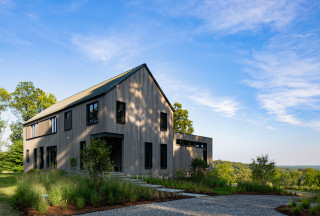
This article was originally published by a www.houzz.com . Read the Original article here. .

A few themes stand out in their advice: Umbrellas are hard to beat for instant shade and flexibility, pergolas and other structures deliver the most reliable coverage for outdoor living, and planting a shade tree is the best investment for natural shade.
This article was originally published by a www.houzz.com . Read the Original article here. .
An earlier post described how the top 10 builders in the country captured a record 44.7% of new single-family closings in 2024. BUILDER Magazine has now released additional data on the top ten builders within each of the 50 largest new home markets in the U.S., ranked by single-family permits. It is important to note that this post does not focus on the top ten largest home builders nationally; instead, it analyzes the top ten list within each of the largest 50 new housing markets.
The 2024 data show that the top 10 builder concentration in the 50 largest markets ranged from 38.9% in Kansas City, MO-KS to 97.8% in Cincinnati, OH. In 11 metro areas, the top ten builders’ market share exceeded 90%. Across all 50 metro areas, the average market share of the top 10 builders was 79.3%, up from 78.2% in 2023.
Looking at the results on a map reveals that southern California, South Carolina, Florida, and parts of the Midwest include multiple highly concentrated markets, while Texas and the Northwest include markets with lower levels of concentration (figure 1).
Lennar and D.R. Horton each made the top ten builder list in 46 markets, the most among all builders. PulteGroup was next with 36 metro markets, followed by NVR and Meritage Homes with 22 and 20 metro markets, respectively.
From 2023 to 2024, 27 metro areas saw an increase in their top 10 builders’ market share, compared with 36 increases from 2022 to 2023. Seven metro areas experienced a double-digit increase in 2024:
Oklahoma City, OK (+20.7 percentage points, 82.8%)
Atlanta-Sandy Springs-Alpharetta, GA (+14.7 percentage points, 76.8%)
Punta Gorda, FL (+11.5 percentage points, 85.9%)
Philadelphia-Camden-Wilmington, PA-NJ-DE-MD (+10.7 percentage points, 87.5%)
Greenville-Anderson, SC (+10.6 percentage points, 89.3%)
Salt Lake City, UT (+10.5 percentage points, 69.8%)
Charleston-North Charleston, SC (+10.4 percentage points, 92.3%)
Meanwhile, 20 metro areas saw a decline in their top 10 builders’ market share from 2023 to 2024, up from only 9 decreases from 2022 to 2023. The largest decreases were seen in:
Miami-Fort Lauderdale-Pompano Beach, FL (-18.1 percentage points, 72.4%)
Los Angeles-Long Beach-Anaheim, CA (-14.7 percentage points, 75.6%)
Orlando-Kissimmee-Sanford, FL (-11.6 percentage points, 76.8%)
Tucson, AZ (-10.4 percentage points, 82.4%
Of the remaining three largest markets, Cape Coral-Fort Myers, FL saw no change in its top ten builder concentration (96.2%) from 2023 to 2024, while Fresno, CA and Spartanburg, SC are new to the top 50 market list in 2024.
Discover more from Eye On Housing
Subscribe to get the latest posts sent to your email.
This article was originally published by a eyeonhousing.org . Read the Original article here. .

Focus on natives. Some of Deborah Gliksman’s favorite shrubs from California are the tall ‘Dark Star’ ceanothus (Ceanothus ‘Dark Star’, zones 8 to 10) and the smaller ‘Valley Violet’ ceanothus (Ceanothus maritimus ‘Valley Violet’, zones 8 to 10). Gliksman also recommends ‘Aromas’ sage (Salvia ‘Aromas’, zones 8 to 10), bush anemone (Carpenteria californica, Zone 9), ‘De La Mina’ Cedros Island verbena (Verbena lilacina ‘De La Mina’, zones 8 to 10), globe mallow (Sphaeralcea ambigua, zones 6 to 9) and St. Catherine’s lace (Eriogonum giganteum, zones 9 to 11). “They’re all stunning shrubs,” she says.
For perennials, Gliksman often uses yarrow (Achillea millefolium, zones 3 to 9), monkeyflower (Mimulus spp.), penstemons and Douglas iris (Iris douglasiana, zones 6 to 10). For ground covers, she loves ‘Silver Carpet’ aster (Corethrogyne filaginifolia ‘Silver Carpet’, zones 8 to 10), ground currant (Ribes spp.) and seaside daisy (Erigeron glaucus, zones 8 to 10).
What not to plant. Gliksman advises against using invasive plants. Besides possibly taking over your garden and even your neighborhood, she says, they can compete with native species and threaten biodiversity.
Your turn: What are your favorite low-maintenance plants to grow in your garden? Tell us in the Comments.
More on Houzz
Read more gardening guides
Get landscape design ideas
Find a landscape designer
Shop for gardening tools
This article was originally published by a www.houzz.com . Read the Original article here. .

This Trending Now story features the most-saved home office photos uploaded to Houzz between March 15 and June 15, 2025.
No matter how you like to work from home, this countdown of the most-saved new home offices on Houzz offers inspiration. Whether tucked into a compact alcove or spread throughout a spacious room, these setups reflect a range of design approaches — each tailored to support productivity, creativity and comfort.
In this Paris home office, Poësis Studio created a serene atmosphere by painting the walls, trim, built-in shelves and ceiling a deep olive green. The color provides a calm backdrop, allowing the crisp white desk and pleated cotton pendant light to stand out.
Paint color: Bancha, Farrow & Ball
Find a local interior designer on Houzz
An elegant arch frames this sophisticated office nook in Toronto. Rosen+Co Design Studio integrated the desk area into sleek built-ins that discreetly hide office equipment and documents. This smart space planning allowed for a comfortable sofa alcove on the opposite side of the room and a prime location for the TV.
Shop for home office furniture
In this Sonoma County, California, home office, Studio CM maximized natural light by wrapping two desks around a corner flanked by tall windows overlooking the front garden. To ensure the space stays bright even on overcast days, the designers incorporated desk lamps and discreet track lighting that align with the home’s classic midcentury modern style.
How to Set Up Your Home Office on Nearly Any Budget
A 14-foot addition and full remodel of this St. Louis Park, Minnesota, home was designed with aging in place in mind. In the new office, Christopher Strom Architects extended the desk along two walls, seamlessly integrating it with built-in shelves and cabinets. The cohesive design draws the eye to the outdoor view and helps the long, narrow room feel more spacious and intentional.
Dovetail Group curated furnishings that thoughtfully complement the refined character of this Zionsville, Indiana, home office. Rich built-ins, a tufted leather chair, an antique desk, a vintage map and classic light fixtures come together to evoke the timeless elegance of a stately library.
Key Measurements to Help You Design the Perfect Home Office
Trim Team NJ masterfully blended traditional and modern styles, along with light and dark elements, in this northern New Jersey office. Integrated lighting and brass accents provide striking contrast against the dark, moody built-ins. The lower cabinets feature classic Shaker-style profiles, while the shelves above maintain a clean-lined, unfussy aesthetic.
Sometimes a home office calls for guitar hooks and cozy seating for strumming, rather than laptops and ergonomic chairs. That was the case in this Nashville, Tennessee-area workspace. Southern Hills Construction enveloped the room in a rich, warm gray paint and installed white oak pocket doors within the arched doorway. No matter the use, soundproofing remains essential in this versatile office.
New to home remodeling? Learn the basics
Designer Carly Zuba of CM Studio achieved a striking balance of light and dark in her own Evanston, Illinois, home office. Light wood floors contrast with black architectural elements in the space. A light-colored desk, chair, rug and chandelier form a bright focal point, while large windows flood the room with natural light.
This article was originally published by a www.houzz.com . Read the Original article here. .

“We also look for people that want to learn and grow and who will thrive within a team environment,” he says. “If a team member is a professional communicator and understands that serving each other is how we best serve our clients, they are Hursthouse material.”
Some skills are harder to find than others, True says. “One is a work ethic of truly caring about the desired result. The balance between an extremely high level of creativity, a terrific communicator and a focused determination to excel at the highest level of client service is a rare find.
“On one hand, I feel it’s getting harder to find special people, as there [seem to] be less people entering the industry,” he says. “On the other hand, people are changing companies more often, so [in some ways] it might be a bit easier. If a company doesn’t take good care of its people, they will have a revolving door — and that’s an opportunity for Hursthouse.
“Our average seniority for team members at Hursthouse is now 13 years, with many over 20, 25 and 30 years,” True says. “We try to have our team sing about how great it is to work at Hursthouse.”
This article was originally published by a www.houzz.com . Read the Original article here. .
The top ten builders captured a record 44.7% of all new U.S. single-family home closings in 2024, up 2.4 percentage points from 2023 (42.3%). This is the highest share ever captured by the top ten builders since NAHB began tracking BUILDER magazine data on new single-family home closings in 1989. The 2024 share constitutes 306,932 closings out of 686,000 new single-family houses sold in 2024. However, closings by the top 10 builders only represent 30.1% of new single-family home completions, a wider measure of home building that covers not-for-sale home construction. Also of note, the top 15 builders accounted for more than half of all closings (51%) for the first time ever in 2024.
The top ten builder share has increased significantly –albeit unevenly– in the last 35 years. In 1989, the top ten builders accounted for only 8.7% of single-family home closings. By 2000, the share had more than doubled to 18.7%, growing to 28.2% by 2006 and 31.5% by 2018. After slight declines in 2019 and 2020, the share exceeded 40% for the first time in 2022 (43.5%) and reached a record high in 2024 (44.7%). (Figure 1).
Meanwhile, the top ten builder share by completions, has also trended upward, with a share of just 5.6% in 1989. It reached double digits for the first time in 1999 (11.3%) and rose to a cycle high of 17.9% in 2006. The share broke the 20% mark for the first time in 2015 (21.0%) and has continued to trend upward since, reaching an all-time high of 30.1% in 2024 (Figure 1).
The top five highest producing builders did not change from 2023 to 2024, with D.R. Horton maintaining its position as America’s largest single-family home builder. D.R. Horton captured 13.6% of the market with 93,311 closings, marking a fourth consecutive year with a market share above 10%, and a 23rd consecutive year atop the list. Results also show that 2024 marked the third year in a row where the top three builders accounted for more than a quarter (29.9%) of overall closings, with Lennar and PulteGroup achieving 11.7% and 4.6%, respectively. With 3.3% and 2.3% of overall closings, NVR and Meritage Homes ranked fourth and fifth on the list, respectively.
Notably, SH Residential Holdings (U.S. subsidiary of Sekisui House, a Japanese homebuilder, who acquired M.D.C. Holdings in 2024) broke into the top ten in 2024, ranking sixth on the list with 2.2% of the market. Clayton Properties Group, ranking 8th in 2023, fell out of the top 10 for the first time since 2019. KB Home (2.1%), Taylor Morrison (1.9%), Century Communities (1.6%), and Toll Brothers (1.6%) round out the top 10 builders for 2024 (Figure 2).
Builder Magazine also released Local Leaders data on the top 10 builders in the top 50 largest new-home markets in the U.S. where ranking is determined by the number of single-family permits, which NAHB will analyze in a later post.
Discover more from Eye On Housing
Subscribe to get the latest posts sent to your email.
This article was originally published by a eyeonhousing.org . Read the Original article here. .

4. Recycled Options
Reusing materials that have proven they can handle difficult conditions — such as stone, concrete and brick —combines resiliency with sustainability. You also can look for composites made from recycled materials. These cut down on waste and reliance on landfills. You’ll often see these materials used for decking and edging as well as other hardscape features. “There are companies that use recycled plastic, such as grocery bags, for fences and benches,” Vogt says. Products made from recycled materials have become much more natural-looking in recent years, and can be lower-maintenance and longer-lasting than natural wood.
This article was originally published by a www.houzz.com . Read the Original article here. .

Chicago is known for its brutally cold winters and hot, dry summers. “Just a few hours north and south of here is a very different climate,” says Jeff True.
Turn to native hardwoods. True says that native hardwood trees can handle weather extremes and are often his starting points. These include several maples, such as red maple (Acer rubrum, zones 3 to 9), sugar maple (A. saccharum, zones 3 to 8; shown here), silver maple (A. saccharinum, zones 3 to 9) and Freeman’s maple (A. x. freemanii, zones 5 to 8).
Native white oak (Quercus alba, zones 3 to 9), which is the state tree of Illinois, is also a tried-and-true favorite, as are swamp white oak (Q. bicolor, zones 3 to 8), Chinquapin oak (Q. muehlenbergii, zones 5 to 7) and shagbark hickory (Carya ovata, zones 4 to 8). “I personally love Kentucky coffeetree (Gymnocladus dioicus, zones 3 to 8) and hackberry (Celtis occidentalis, zones 2 to 9),” True says.
He adds that the new elm varieties resistant to Dutch elm disease, such as Triumph elm (Ulmus ‘Morton Glossy’, zones 4 to 7), are fast-growing, allowing them to fill in spaces quickly.
8 Reasons to Plant a Great Tree
This article was originally published by a www.houzz.com . Read the Original article here. .

We all know that because they’re small and tucked away, powder rooms offer the chance to play outside the rest of the home’s design comfort zone. Vivid colors? Go ahead. Dramatic prints? Be our guest. But a powder room also can be the picture of serenity, drawing from nature to infuse us with calm as soon as we close the door. You’ll find plenty of ideas for any design approach in this countdown of the most-saved new powder room photos uploaded to Houzz so far this year.
This article was originally published by a www.houzz.com . Read the Original article here. .
This elevated indoor-outdoor lounge is positioned on the back side of a luxury mountain home in Big Sky, Montana, just outside of Yellowstone National Park. The team at interior design firm Hive Home brought the same attention to detail to the outdoor space as they did to the home’s interiors, with a rich, earth-tone color palette and a focus on natural materials. A stone hearth serves as the focal point of the outdoor lounge, anchoring the seating arrangement. Overhead, integrated lighting and a heating element keep the lounge warm and inviting on cool evenings.
See why you should hire a professional who uses Houzz Pro software